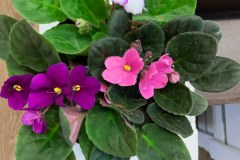African Violets
African violets, the memories they bring back of the writer’s “Granny” growing huge and beautiful violets. All while making it look so easy, which it actually is! Today stunning colorful tri-color violets came in to the gift shop. These little beauties will certainly perk up the remaining gray days of winter. With proper TLC they will be repeat bloomers for many years to come, that’s right, we said YEARS! Here are a few tips for growing violets and if you feel overwhelmed come on in and we can answer any questions or concerns you have.
Avoid plants with soft, droopy leaves and those with brown spots or pests. Plants with a few open flowers and many closed buds will remain in bloom longer after you buy it. Tip: peek under the upper leaves to look for newly forming flower stems.
African violets need bright light to bloom, but cannot tolerate hot, direct sun because their leaves are easily scorched by intense light. Violets bloom best at temperatures from 65 to 75 degrees.
In the winter, violets grow best in south, east, or west-facing windows. On cold winter nights, move the plants away from the glass to a spot that remains above 55 degrees. When the sun gets stronger in the spring, move plants to a cooler east or even north-facing window.
Give each plant a one-quarter turn clockwise every few days to keep the growth symmetrical.
Watering is not as complicated as one would think. Water only when the soil surface feels dry. The pot may feel “light”.
Use room-temperature tap water. Cold water shocks the roots and causes leaf spots.
Let chlorinated water sit overnight before using.
Avoid softened water, which is too salty.
Water from the top or bottom, whichever is easier. Soak the soil thoroughly.
Let the pot drain completely; don’t let plants sit in water!
Try to avoid splashing water onto the leaves and never water directly onto the leaves. Use a high quality violet food, we recommend Espoma Organic African Violet Food.
Violets prefer a well-draining potting soil. Try to find a potting soil with a loose peat perlite mix. When you repot from a nursery pots, remember that the new pot should be about one-third to half the diameter of the plant. For example, a 7-9″ plant should be in a 3″ pot. A 9-12″ plant goes into a 4″ pot. Choose shallow pots for best drainage and root aeration. Repot your plant in fresh soil and a clean pot once a year.
Violets are very easily propagated. Often a healthy leaf allowed to root in a glass of water will produce another violet that you might want to pass along to a friend or family member.
Spacing is important. Try to keep your violets from touching each other and to allow for good air circulation around the plants.
When you see the blooms on your violet start to die simply reach in and pinch that bloom off as close to the plant as possible. Nothing makes a violet look more sad than dead flowers.
Violets can be susceptible to some pests, like Aphids and Mealy Bugs. Most pests can be easily treated. If you notice something unusual on your plant, please bring us a photo and we will do our best to diagnose and offer suggestions for treatments. Sadly, there are times when the best we can offer is “last rites” for the plant. But that’s okay, just buy a new one and start over!
Violets, or houseplants in general, are a fun and rewarding hobby!








